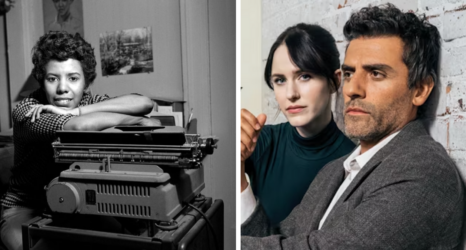In a recent blockbuster novel, young girls and then older women suddenly develop a power, a force. Electric jolts shoot through their fingertips in wide and elegant arcs, lighting up the night sky—and sometimes lighting up their male assailants. The tables are turned and male physical power is rendered moot.
But the welcome respite from all the Handmaid’s Tale-type dystopian fiction that has bloomed in the past few years inevitably unfolds into a same-old same-old scenario. Women turn out to be just as bad as men, wielding power ruthlessly and establishing an inverted gender hierarchy.

I’m talking about the epic HBO extravaganza “Game of Thrones”—in which the warrior queen who harnesses the power of dragons to free slaves and liberate the world turns out to be as power-mad as the men she conquered, and, at the pathetic end of the series, is killed by her perpetually-pained and ever-honorable lover and nephew.

Meanwhile, “The Good Fight”—a follow-up to the CBS feminist favorite “The Good Wife”—features an increasingly politicized and always elegant Diane Lockhart, joining “the resistance” only to find that the tactics used by anti-Trump women are as nefarious as the Russian trolls and neo-Nazi acolytes. In Veep, funny but awful presidential wannabe Selina Meyer is as venal and greedy as the men, even telling a female opponent to “man up” in an effort to derail her competitor’s campaign.
Fact is a lot more revealing than fiction here. From the gloriousness of soccer star Megan Rapinoe’s full-throated feminism, to the phenomenal work of contemporary women-led social justice movements such as Black Lives Matter, the Women’s March and the Fight for 15 labor campaign, we are all witness to the benefits of female-led and staffed organizations.
And that’s not even counting what happens when feminist women gain political office. The bold 2018 victories of Alexandria Ocasio-Cortez, Ayanna Pressley and the rest of the “Squad” prove each day that women can, and often do, lead differently.
Of course, many women do not act for women as a class. Numerous examples—Britain’s former Prime Minister Margaret Thatcher, who largely promoted men in her government and whose policies were notably indifferent to most feminist concerns; Alabama Governor Kay Ivey who recently signed the country’s most draconian anti-abortion bill—illustrate dramatically the difference between “women” and “feminists.”
These women and others like them may have gained individual power as women, and they may even want more women to have that power, but they aren’t living feminist lives, imagining feminist futures, acting for and with women as a class. They don’t have—to put it mildly—an analysis of patriarchy. So, yes, women can and do act badly. Women can and do lead with violence and brutality.
But the argument that women are or will be “as bad” or “the same” as men in power, and that to argue otherwise is to subscribe to some idea of women’s natural goodness or inherent empathy, is belied by the evidence.
One of the most galling examples of this regressive fiction are the middle-aged, professional women of “The Good Fight” who start a “book club”—really a code name for an anti-Trump action group—which incongruously morphs into a secretive cabal furtively conspiring in a macabre church basement, plotting violence and vengeance.
That has happened never. But that plot serves its ideological purpose—to convince viewers that women fighting back will employ the same ugly tactics as men, thus disarming the radicalness of feminist resistance.
Why do we imagine women will be as awful as men? What actual evidence do we have for that? Men have had centuries to hone their badness and perfect their blasé privilege. Maybe we women could learn that—maybe we could rise to the occasion if given centuries of unfettered power. Who knows?
But feminists? No way we’re as bad as men.

Moreover, the idea that simple parity won’t matter has also been shown to be false—at least in some cases. The nearly 50 percent of women both the Parliament and the Cabinet in Sweden and many of the other Nordic countries surely is one reason that these countries often come out on top in various surveys of “best countries for women.” The Swedish minister of gender equality—yes, they have that—credits “the perspective brought by women legislators for a whole list of initiatives, from improved child care, better protection for pregnant women, more opportunities for working mothers and fair tax rates for wives.”
Both Iceland and New Zealand provide ample evidence that—in the words of former Prime Minister of Iceland Johanna Sigurdardottir—“women are generally better than men at ensuring fairness in society.” She should know: After Iceland suffered a catastrophic banking crisis in 2008, it was female leadership that got them back on solid ground, both in government, with a female prime minister and gender-balanced cabinet, and in the few banks run by women that, interestingly, made few of the errors of the male-run banks and weathered the storm. Earlier, in 1975, 90 percent of Iceland’s women participated in a national strike that set the stage for these later initiatives.
Over in New Zealand, feminist Prime Minister Jacinda Ardern displayed unusual compassion in the aftermath of the anti-Muslim mosque shooting that killed over 50 people—then made sure that strict gun laws were passed. In addition, her expansive national agenda is framed by an intersectional, ecological feminism that pulls few punches.
Sweden, in yet another example, calls itself a feminist government with a feminist foreign policy. They put explicitly feminist values and perspectives into action, from evaluating how successful a particular policy is—does it create more equality?—to the actual policies themselves. The government works to make the playing field more equitable with ample parental leave, equal pay laws and aggressive prosecution of sexual violence; while at the same time diving deep into the de- and re-construction of how we think about gender through rigorous early childhood educational challenges to gender stereotypes, feminist sex education and gender-neutral pronouns.
The idea that women’s voices and policy initiatives—and sports team ethos—don’t have a substantive impact on just about everything from government to corporations to universities is just patriarchal “fake news.” Numerous studies here in the U.S. show that women legislators, on average, introduce measures that do in fact benefit women, measures that are often simply ignored by male politicians. Importantly, both national and international research shows that women legislators really just do more: they both sponsor more bills AND get more bills passed.
Male politicians can’t narrate the stories of their abortions when women’s right to choose is being eviscerated. They can’t nurse their babies in public to destigmatize the realities of mother’s lives. They can’t recount the gauntlet of harassment they went through just to get access to male places of power. They can’t get a stadium full of people to shout “equal pay.”
In business, in universities, in community organizations, in every conceivable venue, the experience of gender, of gender discrimination and violence, of roadblocks and denigration and stereotypes shapes our varying approaches to power. In other words, simply having more women in positions of power might go some way to ameliorating the worst effects of patriarchal domination.
“It’s time for women to run things,” says MacArthur “genius” award winner and director of the National Domestic Workers Alliance Ai-Jen Poo. “Women are really the superheroes of this moment,” agrees Black Lives Matter founder Alicia Garza. “We’re sending out the bat signal.”





